Symbols of Sliven and historical monuments
The symbols of Sliven are impressive and legendary – The Blue Stones, the old elm-tree, the monument of Hadji Dimitar, the monument of the 7th cavalry regiment – “The eaglet”, the town clock, Dobri Zheliaskov`s factory, Chintulov's songs… symbols uniting the spirit of enterprise, the rebellious flame, the impulse of the enlightenment. Even for those visitors of the town who are not acquainted with Bulgarian history, these symbols make sense because they are not forgotten pieces of history but represent a part of the contemporary atmosphere of the town. In Sliven history and tradition meet modern dynamics and diversity – a combination, hiding the unique charm of the town below in the foot of the Blue Stones, “ ... the town which has gathered together the old and the new, cobbled streets and asphalt, an old-time verandah and multi-storey buildings,…gathered together not only winds and rives (from there arises its name), but gathered together past and present, today’s joy and the agony of the past.” (Damyan Damyanov).
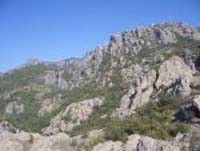
The Blue stones
“Above all is the azure– mat lights of the Blue Stones, which will give true colors of our days, from the first one to the last one.” (Konstantin Konstantinov)
“Sliven has many symbols. Most famous are the Blue Stones. They shine in the violet sky above the town, after spring rain, when the air is fresh and sunny. They are as blue as sea in a hot summer day. They are grey in autumn, when the famous wind chases clouds above them…” (Damyan Damyanov)
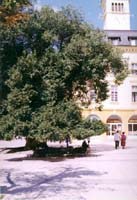
The Old elm-tree
Its name is a field elm tree. It’s a natural over 1000 - year phenomenon. It’s a relic from the Great Bulgarian forest (Magna silva Bulgarica) that spread from the Rodopi Mountain to the Black sea. There are about 20 elm trees like this one left in Samuilovo village, situated 7 km far from Sliven. All of them are declared for protected trees and people take care of their protection.
The old elm-tree is a part of Sliven history in the time of the Turkish yoke. “This tree is famous, it is one of the symbols of the town. It was a place of execution and a sacred place; a monument of the mutinous unbendingness of people of Sliven, the Old elm-tree is at the same time touching, hardy representative of a threatened of extinction plant species. It is not sure if exactly the here the Turkish enslavers had hung the Bulgarian rebels long time ago, but people of Sliven love this tree of wisdom and look after it.”(Damyan Damyanov)
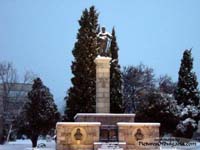
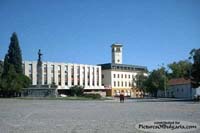
The Monument of Hadji Dimitar
One cannot imagine Sliven without the presence of the legendary voivoda Hadji Dimitar on the central square. One of the unique symbols of our town, the monument is a testimony to the glorious heroism and the gratitude of people. It was built in the period 1931 – 1935. The opening ceremony was on 8 November and it lasted for three days. The authors of the monument are the sculpture Stefan Peichev and the architect Yordan Yordanov.
The monument has a complex architecture-plastic structure. The figure of the legendary Hadji Dimitar voivoda of Sliven (3.60 m) was built on a high pedestal (12 m) and it emerges clearly on the background of The Blue Stones mountainous national park. The busts of the Sliven participants in the Bulgarian national revival Panayot Hitov, Dobri Chintulov, d-r Ivan Seliminski, d-r George Mirkovich, Sava Dobroplodni, George Ikonomov, Ivan Dobrovski are put at the footing of the monument.
The monument was thoroughly restored in 1993-1994.
“Hadji Dimitar Asenov is a Sliven citizen, but he belongs not only to Sliven, he belongs to Bulgaria and every part of Bulgaria considers him its hero. P-eople of Sliven are proud with his historical town, and that here was born a man, a giant, recognized by all Bulgarian people, songs have been dedicated to him, legends speak about him and his legendary name passes along next generations.”( „Speech of the opening ceremony of the monument” in 1935)
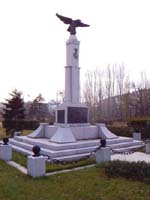
The Monument of 7th Cavalry Regiment – “The Eaglet”
One of the symbols of Sliven is the monument dedicated to the glorious 7th cavalry regiment of Sliven which participated in the Balkan war, the Inter-ally war and World War One. The authors of the monument are the sculptor Nikola Dimitrov and the photographer Panaiot Tziparanov.
Originally erected as a donation from the residents of Sliven and it was consecrated on 28 November 1928 by Ilarion - a metropolitan of Sliven. In 1996 the monument was renovated thanks to significant donations from the National donations fund – “13 centuries Bulgaria” and the Municipal council of Sliven, the command of Third army and from “Open society” club – Sliven
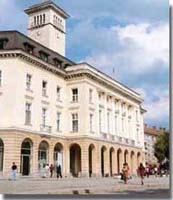
The Town Clock
The town clock is one of the significant symbols of Sliven with a particularly attractive presence. The construction of the new Municipal building, above which soars the clock tower, was finished in 1936. Three years later in the clock tower are placed the mechanical heart and the round face of the town clock. The old one, made in 1808 by the skilful hands of Atanas “the clockmaker” and thanks to the significant contribution of the residents of Sliven, now remains only the bell has left. Today the town clock measures the hours and reminds us of the continuity and the irreversibility of the passing time.
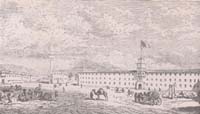
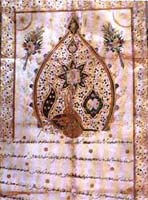
The Factory of Dobri Jeliaskov
Even in the 18th and the early 19th century the wool textile production of Sliven was widely spread in the limits of the Ottoman Empire. Having left Sliven during the mass migration of its residents to Russia after the Russian-Turkish war (1828-1829), Dobri Jeliaskov settled down in Ekaterinoslav where he got acquainted with the development of the textile industry in Russia. There he took down models of looms, spinning wheels and carding machines, some of which he bought, and in 1834, after his returned to Sliven, he established a specialized workshop for production of wool cloth with the division of labour typical for the manufacture.
The quality and the appearance of the cloth produced by Dobri Jeliaskov provoked the interest of the Turkish administration which regarded the cloth as a means of reducing the import. Dobri Jeliaskov was therefore summoned by the sultan to show patterns of the cloth he manufactured. They were approved and, as a result, with the famous sultan’s royal decree in 1836, Dobri Jeliaskov was given a free hand by the government to produce cloth of the presented samples. The royal decree indicates: “Men like him who are in my empire, deserve my imperial goodwill.”
The Songs of Chintulov
Sliven is the native town of the patriot Dobri Chintulov (1822-1886), a national teacher and a poet, an author of revolutionary songs which inspire the people in their struggle against the invader, songs that deeply move people up to the present day as an expression of national pride and love of freedom.
“Symbols of Sliven are, if you agree, the songs of Dobri Chintulov. Especially when in the covered up with branches yard of his house, in the day of Dobri the Teacher – that is how people called him, a violin or a trumpet plays silvery the melody of “Where are you, faithful people’s love...”, and Your heart starts repeating the true words, which can be said by these sounds only. Chintulov’s ideas have so much accreted with our mind, that the hero in Sliven’s emblem calls his brothers in arms, blowing his trumpet, riding his horse over the Balkan Mountains”. (Damyan Damyanov)